Hello everyone, this is Uri, Guerrilla Poker. Today I have two high-stakes hands for you. One of them was played by Magnus Carlsen on a cash game stream from the Hustler Casino. The second was played by Stefan and Kalapoju in heads-up at PokerStars.
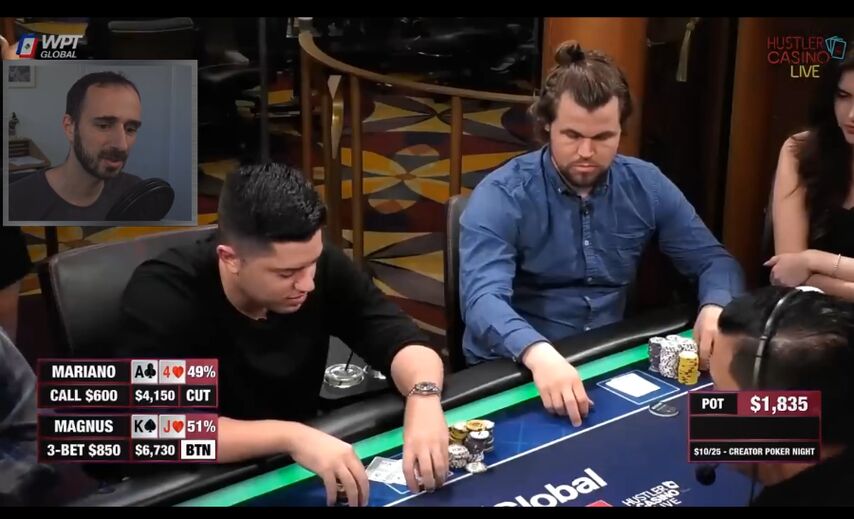
I'm not entirely sure preflop whether there was a straddle or a limp, but it's not that important. We see that Mariano raised to $250 (10bb) from the cutoff with and Magnus 3-bet to $850 with . Everyone folded, Mariano called, and the players saw the flop.
In a GTO environment, Mariano would fold his hand and Magnus would fold KJo when he saw a raise. So the hand from the very beginning goes into the category of exploit. As long as you don't know how your opponent plays, in Magnus's shoes you can play theory and fold tight with hands like KJo. But Magnus seems to think that Villain will deviate from the GTO and play a lot looser, so he can be 3-bet wider. Indeed, if A4o is in the opening range, a 3-bet with KJo becomes good. You can praise Magnus for the fact that he figured out the preflop action perfectly. Knowing the theory is useful, but we need it as a base, not a mandatory guide to action.
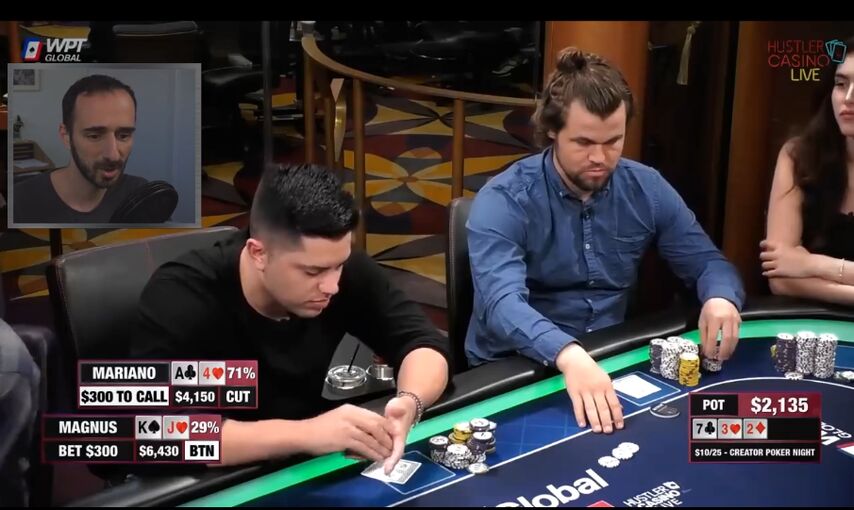
The flop is extremely dry and Magnus c-bets a small $300. The size of the continuation bet in these situations is determined by the texture and ratio of the pot to the effective stack. The SPR on the flop is about 2.5. With small SPRs, it is possible to put pressure on opponents with small bets, and this is exactly what Magnus does. However, on low boards, Villain gets to float small bets just with backdoor overcards or Ace-Highs, so I feel like 1/6th of the pot is not enough to bet. It's too easy to play against such a continuation bet.
Mariano calls. His hand should be a mix of call and check-raise, but against such a small sizing, calling looks very tempting, of course.
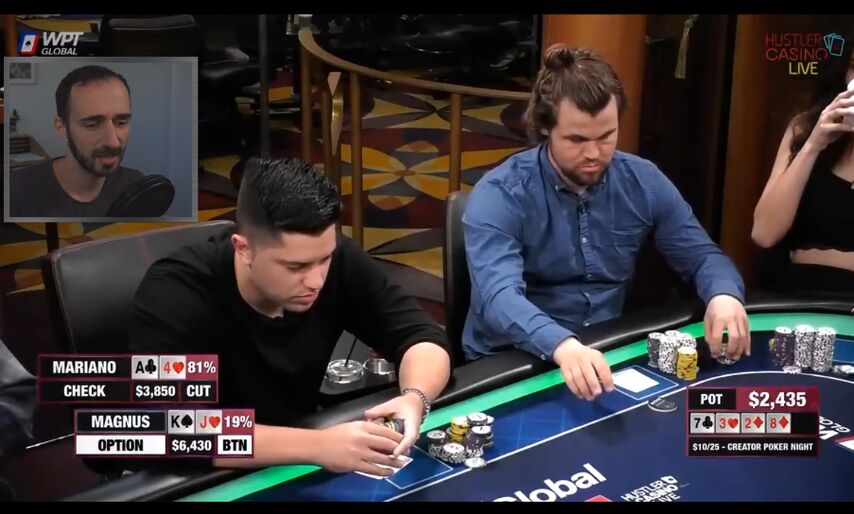
The turn suits Mariano better than Magnus. Mariano checks, and Magnus checks next. Checking is quite reasonable, he will have better hands for the second barrel. Although sometimes you can bet to knock out or , clear out some of those.
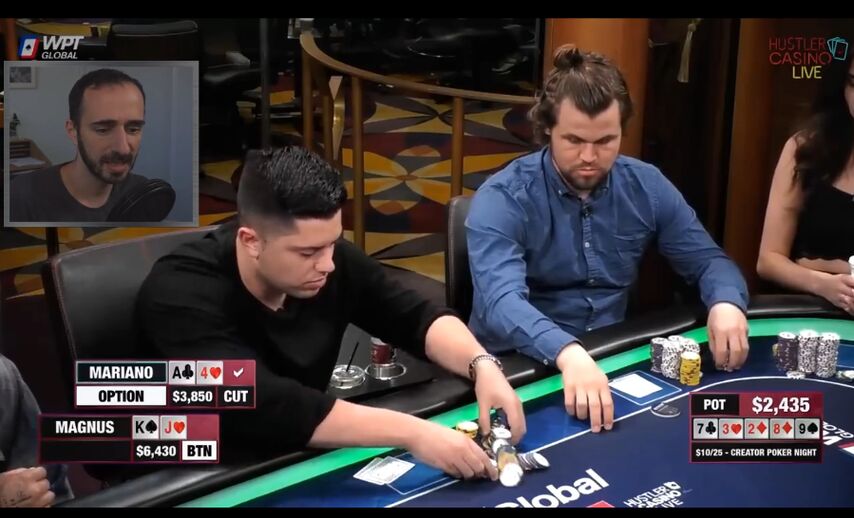
The most interesting thing in this hand happened on the river: an offsuit nine came out, and Mariano moved all in. Magnus asked for a count.
"I'm looking at the hero call here," he said, leaning back in his chair. “And if I do it, it will be real heroic.
"But wouldn't that be disrespectful to me?" – said the opponent.
“To a certain extent, yes,” Magnus smiled.
– I think you can beat .
– Well, this particular hand – yes, of course.
– ?
– No no. I have king high.
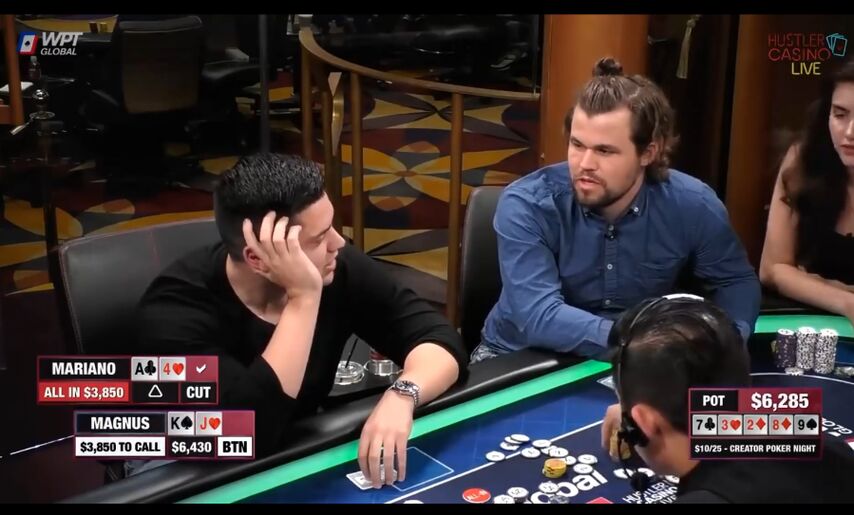
– Ha-ha-ha! Magnus, don't call, don't, – the opponent said and took a drink.
– Well, I beat , , and I don't think you would shove an ace. Good ace, anyway. So king-high is the same as ace-high.
– No, not the same. I may have or .
– But why would you push them?
Because you might have .
– Well, I agree. But you still have showdown value with these hands, so I don't think you'd shove them. However, you still have too few hands for me to call positively.
And Magnus decisively threw the cards in the muck.
"Yes, I'm the worst. Worst,” Mariano said as he raked in his chips, then flipped over his cards.
“Yes, you are the worst,” Magnus confirmed.
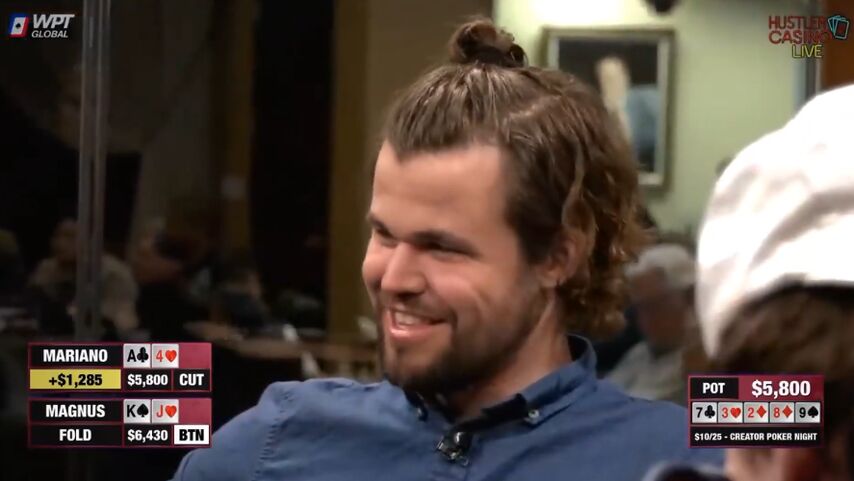
Very exciting hand and very interesting discussion on the river!
To begin with, I would like to note that in chess Magnus Carlsen is especially famous for his endgame technique. River play, the art of catching bluffs, is the poker endgame. And you can see that Magnus is seriously considering calling. He sees an overbet all-in on the board and asks himself: which hands will he overbet for value? All sets and , for example. With some of them he would check-raise the flop, but let's say Mariano doesn't check-raise. It turns out 15 combinations of sets and 4 combinations of straights, 19 combinations of value. And how many combinations of bluffs? Four combos of 54s, three combos of QJs... That's what Magnus is running in his mind, and not enough bluffs come up. Let's add 64s, there are 11 combinations – already closer to the call, because the opponent has made an overbet. And if you add QTs, then calling becomes quite reasonable.
Quickly counting combinations on the river in your head is a difficult task, but very useful. Many players are great at catching bluffs with these ballpark calculations without even thinking about GTO and balance, because they have a good feel for how their opponent will play with different parts of the range.
It was a mistake in Magnus's reasoning to think that Villain's ace-high had showdown value. It pretty much depends on the situation. In a once-raised pot, yes. In a 3-bet pot, yes, but... On a full table after a 10bb raise and a 3-bet, the ranges narrow a lot. The bottom of the range for Magnus in this situation should be , , , so all hands weaker than Mariano can turn into bluffs, including and . I don't think I'm bluffing with – it's a mistake, I like his line. I don't know much about Mariano, but I don't think he's quite an amateur. On the stream, he played very loosely, but from his decisions and conversations, it seemed to me that he understands poker.
Overall, I get the feeling that Magnus lacks the knowledge and experience of 6-max or 9-max cash games when considering hero calls with K-high in 3-bet pots. However, he eventually folded! And the way he thought about the situation was absolutely correct – he counted the combinations, he simply misjudged the limits of the strength of the hand, below which Mariano should not bluff.
In the next hand, players of a completely different level collided. Stefan vs. Kalapoju, $25/$50 heads-up at PokerStars 139 blinds deep.
Kalapoju raises to $115, Stefan raises to $650, about five times which is pretty standard in this situation. Kalapoju calls.
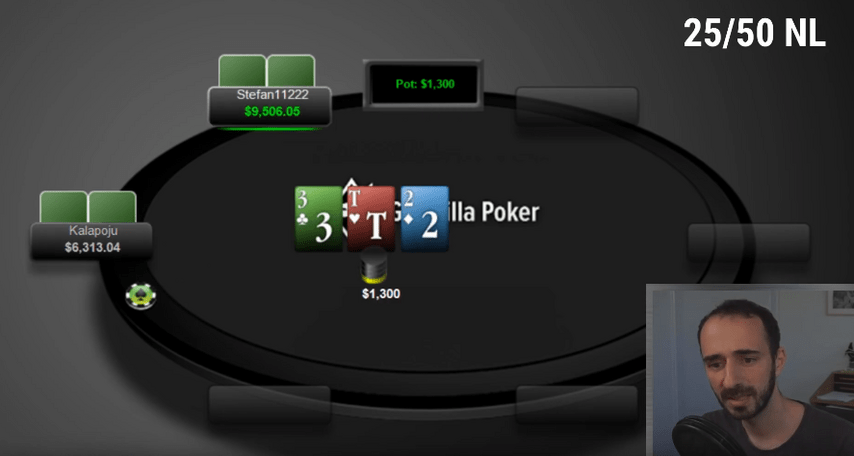
On the flop, Stefan bets about a third of the pot, $428, hinting that he's betting all hands or just very wide. Kalapoju calls.
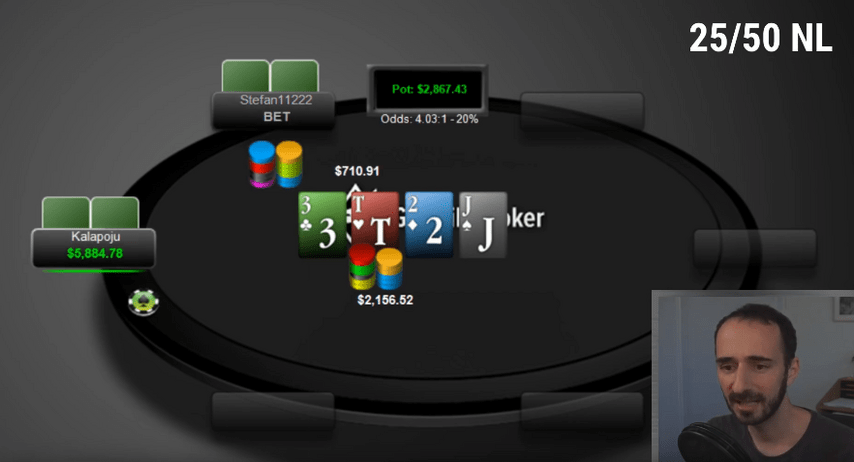
On the turn, Stefan continues to bet a third of the pot and gets called again. What is the idea behind this sizing? When the turn hits an overcard, we have a cluster of hands that want to bet for value and defense but aren't good enough to pile. In particular, the weak ten, , ... The problems facing such hands are solved by a small bet. It's also clear that this sizing isn't good for our nut hands, which means we're playing double sizing on the turn.
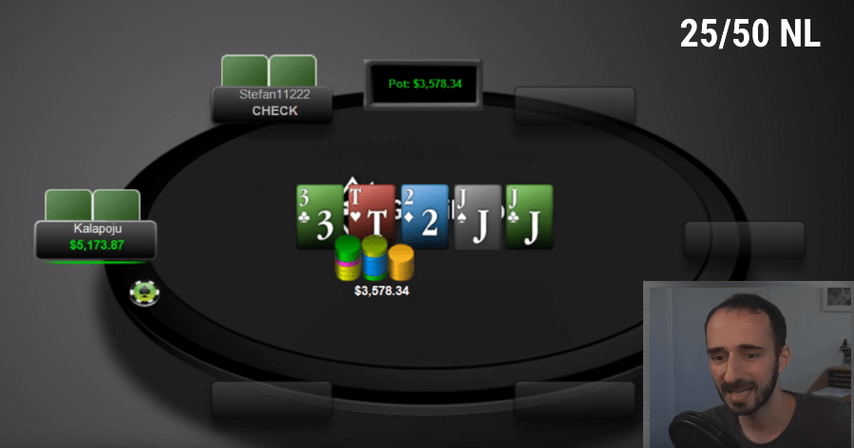
The river is a repeat Jack, and Stefan checks. Kalapoju goes all-in for a pot and a half. Stefan calls.
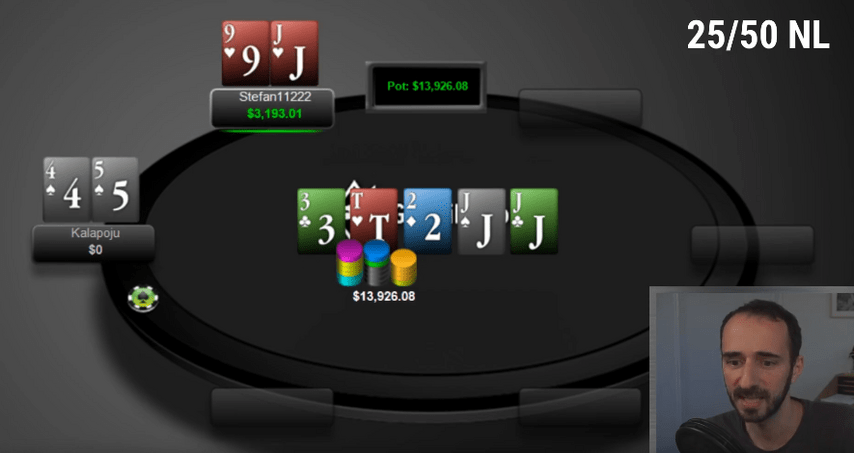
With 54s the line looks very reasonable – always a raise call preflop, always a call on the flop and turn (maybe a raise sometimes, not sure), and always a bluff on the river. Maybe not necessarily all-in, you need to think about sizing, but bluffing is clearly necessary.
Stefan played very standard before the turn, but from the turn, he began to deviate: with his hand, it is quite possible to bet big. And, of course, he logically continued to portray weakness with a cunning check on the river.
When you are tempted to set a trap, ask yourself how appropriate the situation is and how suitable your hand is. I think the purpose of playing his strong hands with the bet third turn and check river line is to prevent our opponent from overbetting him. , and . On the river, we want to check the fraction of hands that beat this range or even check-raise for value. Trips, in my opinion, are too strong for this, and even a nine is not the best blocker if we want to limit the possibilities and . It's better to set a trap with than with , but overall I find trips to be an overly strong hand.
We rarely do this, but let's open the solver and see what it thinks about Stefan's line.
On the flop the solver agrees, but on the turn, the solver surprises me by completely abandoning block bets.
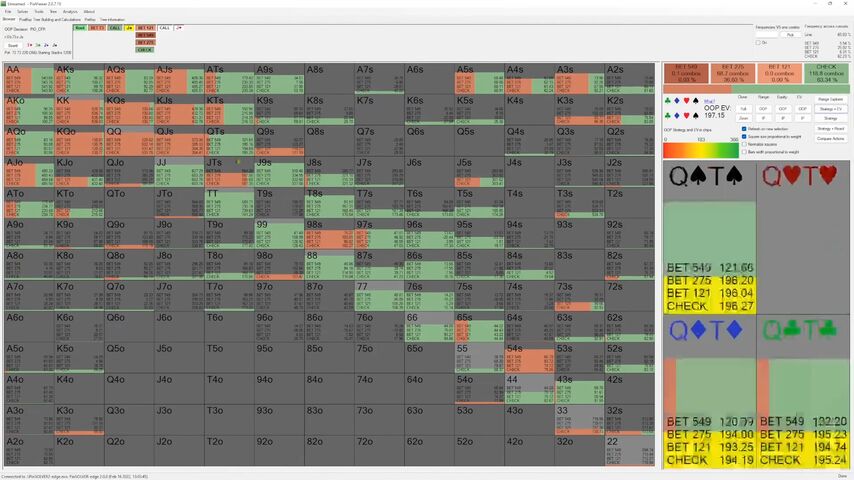
The third pot sizing only appears on pairs and sometimes on an ace. It doesn't exist in other scenarios.
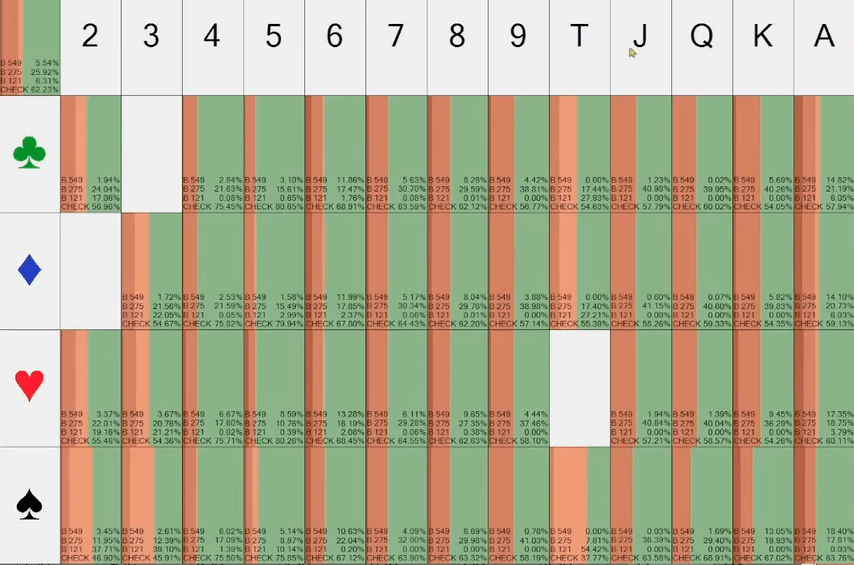
Consciously, Stefan chose a non-optimal line or not, he set the opponent a problem that needs to be solved. Maybe his sizing loses EV, but if the opponent doesn't find the right decision, the benefit may outweigh it.
Here's what I'll do to continue analyzing the hand, albeit a little artificially: I'll leave the solver with two sizings, 33%, and 150%. In this case, part of the hands will probably go to a third pot sizing.
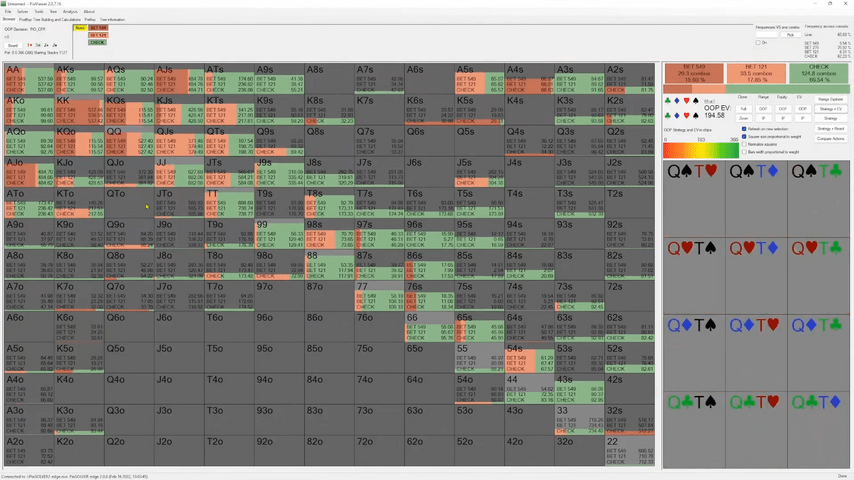
This is true. And J9s mostly checks, but bets third with little weight. Raising with 54s for your opponent is a big mistake, calling is correct. Semi-bluffing is best done with 65s and 64s gutshots but with not too much weight.
Bet, call, get to the river.
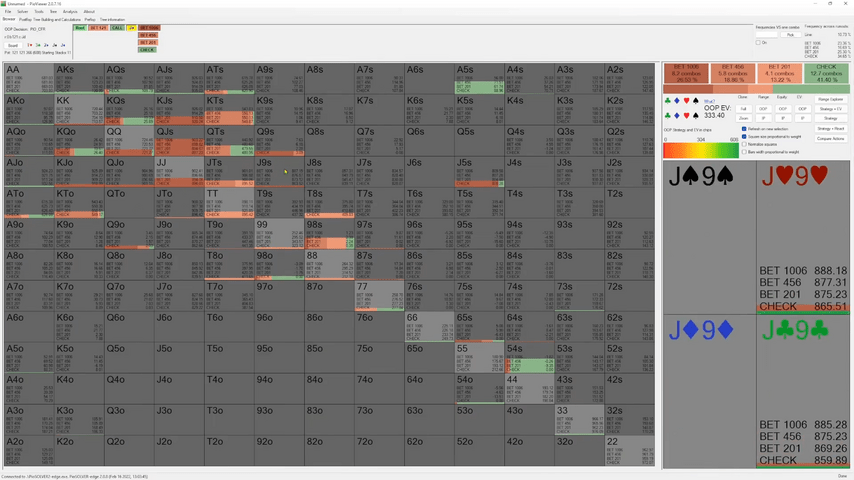
And we see that the solver thinks Stefan's trips are too strong to check. It sets traps with , , , and with prefers push.
However, these are not errors, but rather nit-picking. Let's take a closer look at Villain's strategy for checking.
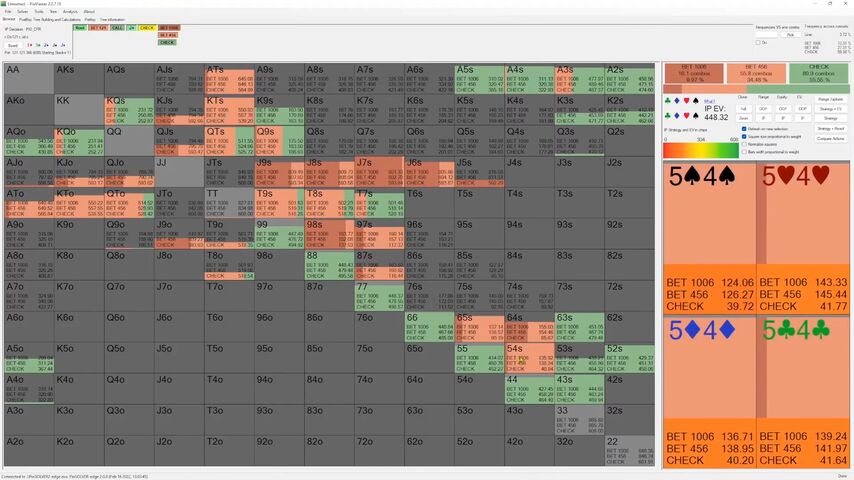
The solver does not push with 54s, but makes a small bet – the same as with . And are too weak to draw, it checks them. An all-in with 54s is certainly better than a check, but is slightly inferior to a regular-sized bet by expectation.
In general, we can say that Stefan's line is justified in practice if Kalapoju bluffs against it more sharply and aggressively than the solver.
